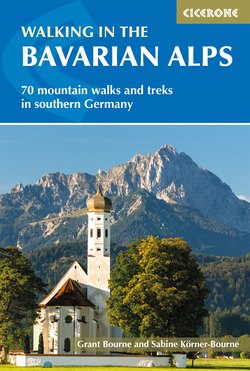Читать книгу Walking in the Bavarian Alps - Grant Bourne - Страница 11
На сайте Литреса книга снята с продажи.
ОглавлениеPART I: THE ALLGÄU ALPS
The ridge trail between Sonnenkopf and Falken Alpe (Walk 3)
The region is almost as well known for its cows as for its mountains (Walk 6)
The main chain of the Allgäu Alps forms the German–Austrian border between the rivers Iller and Lech and is located within the Allgäu, a popular tourist region encompassing that part of the northern Limestone Alps and the alpine foothills between Lake Constance (Bodensee) and the River Lech. Included within the Alpine Club’s definition of the group is the area known as the Allgäuer Voralpen to which such peaks as the Fellhorn (2037m) and Hoher Ifen (2230m) as well as the Gottesacker Plateau (2017m) belong. Among the highest peaks in the Allgäu Alps in German territory are the Mädelegabel (2645m), Hochvogel (2593m) and Nebelhorn (2224m). The highest peak is Großer Krottenkopf (2657m) on the Austrian side of the border. Also covered here is the Kleinwalsertal, which lies in Austria but is only accessible by road from the German state of Bavaria.
Although it is not the driest region in the Alps (precipitation averages between 1000mm per year in the valleys, and 2000mm per year in the alpine regions), the Allgäu is blessed with a relatively mild climate which, combined with its great diversity of soil types, has contributed to a richly varied flora. There is no other region in the Alps where so many different species of wildflower grow so close together. In spring soldanellas and crocus push their way up through the retreating snow, while dark blue gentians dot the drier slopes. Early summer is the time for red alpenrose, yellow gentian, monk’s hood and alpine aquilegia to decorate the mountainsides. Those who are lucky might even find the rare lady’s slipper orchid or the famed edelweiss. In autumn carline thistles and purple autumn crocus (meadow saffron) offer some compensation for the shorter days and cooler temperatures.
The Kleinwalsertal
This valley was settled by farmers from the Valais, a canton in Switzerland, in the 13th century. Although it has belonged to Austria since 1453 it is only easily accessible from Germany. This caused problems for farmers when it came to selling their produce within Austria as they had to cross high alpine passes to get to markets in the south. In winter they were completely isolated from the motherland. This difficult and economically disastrous state of affairs came to an end in 1891 when Austria and Germany signed a treaty which exempted the ‘Walser’ from the need to pay duty on goods brought to and from Germany.
The valley is entered at Walserschanz (no customs post), only a few kilometres southwest of Oberstdorf. For mountain walkers the Kleinwalsertal provides plenty of carefully waymarked trails and magnificent scenery. A bus (Walserbus) runs daily (May–October, every 30min) from Oberstdorf railway station to Baad at the end of the valley.
